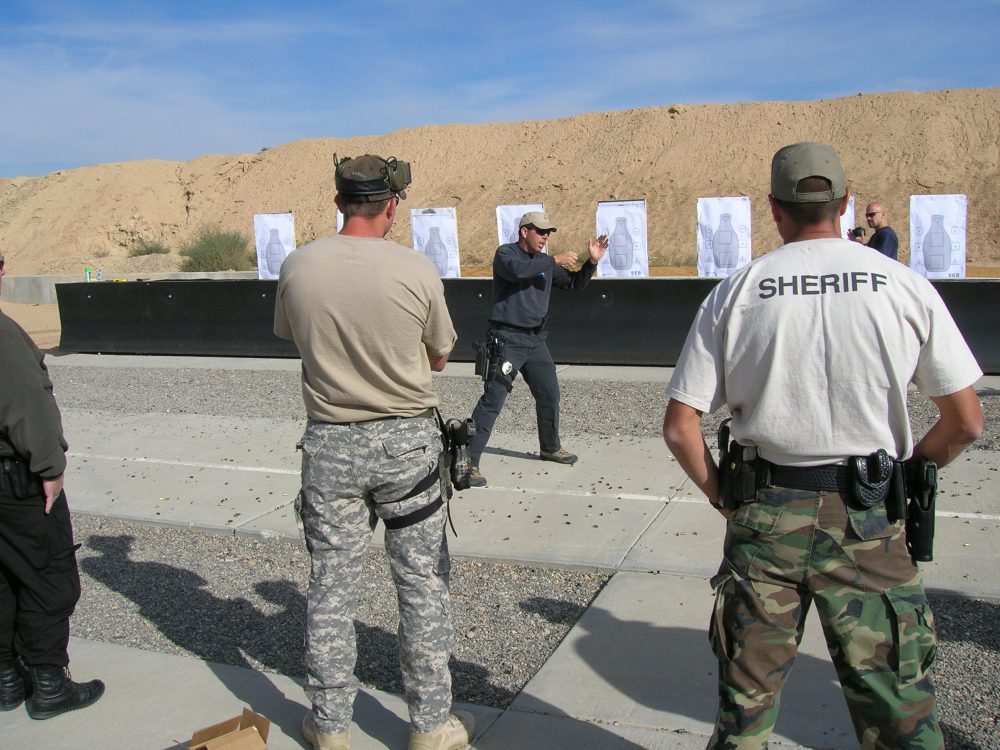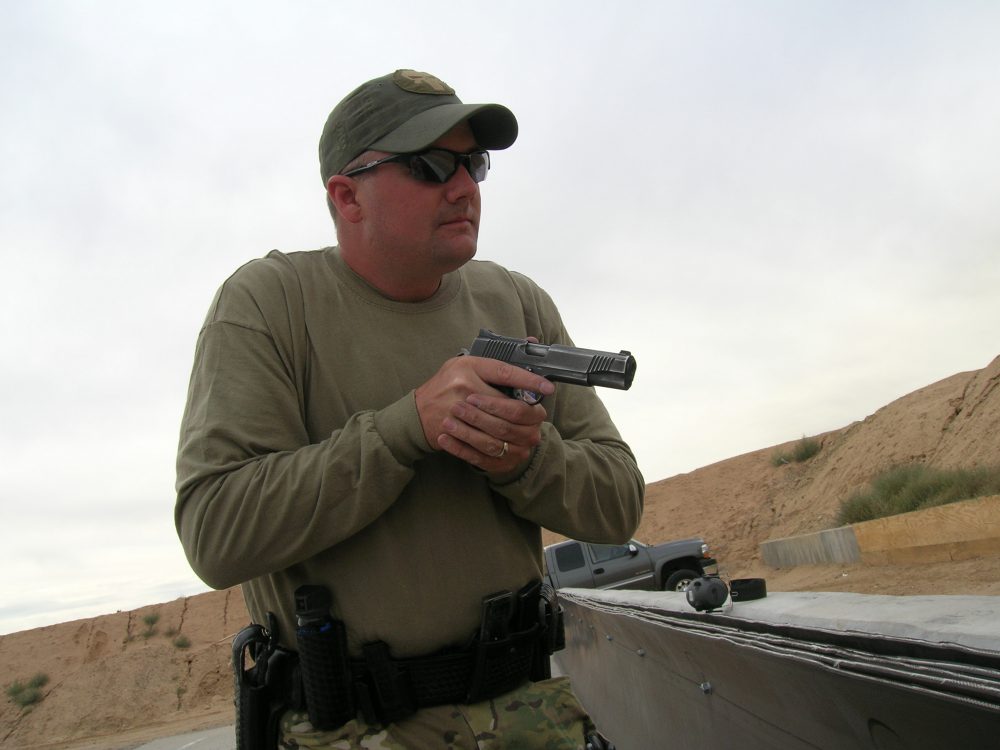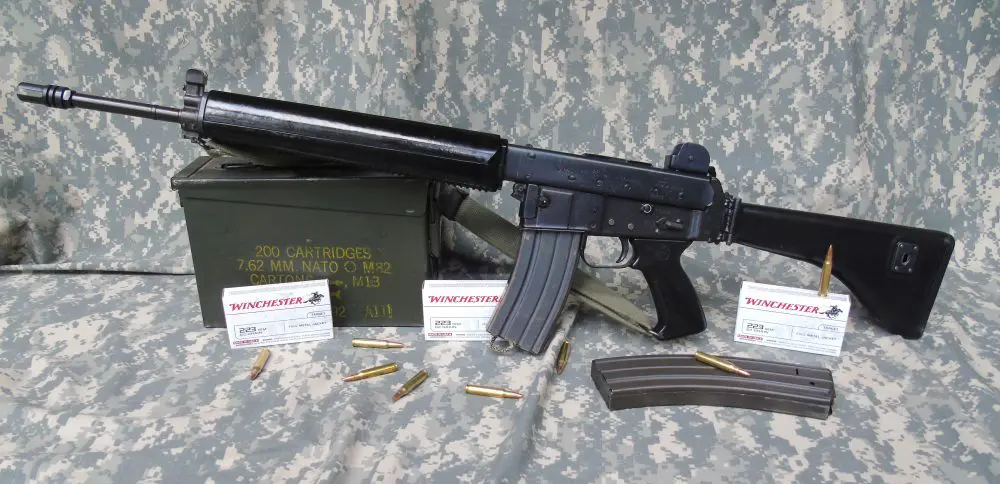Rob diagnosing a target. He refers to misses during training as learning opportunities.
Within just a few short years, Valhalla Training Center has gone from relative obscurity to being one of the country’s top training centers. This is in no small part due to the Combat Focus™ course developed by Rob Pincus—Valhalla’s Director of Operations.
Combat Focus is an instinctive shooting technique that is based on studies from real violent encounters and that builds on the body’s natural reaction to an attack and at the distances that gunfights typically occur.
A few months ago, I was invited to cover an offsite Combat Focus Instructor Development course for S.W.A.T. I had time off coming from my department, so the morning of 30 September found me in Farmington, New Mexico. The instructor for the course was none other than Rob Pincus himself.
Rob Pincus during classroom instruction on Day One.
Table of Contents
DAY ONE
One of the first things emphasized in the introduction was the word “intuitive.” This is what the body does naturally under stress. There are several things that happen automatically: your head looks toward the threat and you orient your body toward it; your hands come up to defend your heart and throat and you lower your center of gravity to be able to move; your heart rate quickens, increasing blood flow to the back of the eyes (the cones), where the information is then pushed up to the thinking part of the brain. During this time you may experience tachypsychia—a neurological condition that distorts the perception of time and contributes to tunnel vision. All of these things are normal, and contribute to the “fight or flight” response found in all animals—humans included.
The next topic was a discussion between speed and precision. For example, if an assailant is charging you with a knife at 15 feet, you’re going to need speed, but you still need to be able to get good hits. If you are faced with a situation where a bad guy is holding a hostage as a shield, your need for precision is obviously much greater and more time needs to be taken. The goal is to significantly decrease the target’s ability to present a lethal threat in the shortest time possible.
Student instructs class on second day of course.
The last thing Rob discussed with the class before heading down to the range for the hands-on part of the class was combat accuracy. Everyone wants to stack rounds on top of each other and cut out the center of the target, however, on a human being that does not cause maximum damage. Rob asked, “Do you want two rounds one inch apart in four seconds or four rounds six inches apart in two seconds?” Clearly four rounds is better than two and, high in the center of the chest, a six-inch group is not bad.
After the “chalk talk” was over, we went to the range to learn the skills of Combat Focus.
The shooting started at very close range. The drill was to bring the gun up in the line of sight, touch the trigger, then press the trigger without looking at the sights. Not looking at the front sight took a little time getting used to, but everyone was soon getting good hits.
Student explains natural reaction to stress, and how hands come up to protect head and neck.
The class then proceeded to working on a compressed ready position, where the pistol is held in tight and close to the body. The advantages of using this as the primary guard (ready) stance were discussed. The benefits include less fatigue, as it is easy to stay in this position much longer than the classic “low ready”; weapon retention is much better, as is the ability to clear malfunctions; and finally it becomes part of the draw stroke, with the final part of the draw stroke being to “punch out” toward the target.
More shooting with the commands up, touch, press was done, as well as double shots and triple shots. Not keeping to firing two or three shots is a good thing, as it is possible to get in a rut thinking that is all you need to fire.
Pincus shows how different targets can be used to get shooters to think.
Rob emphasized that every missed shot was nothing more than a learning opportunity, and not to dwell on a miss, but rather learn from it and carry on.
After lunch we put up 3D targets of a man with a gun and worked more on combat accuracy and speed vs. precision. As the class moved farther from the targets, the need for precision and taking a bit more time became apparent. As we moved closer, the speed was increased.
Rob then brought out targets with numbers, shapes and colors. At the command “up,” Rob would call out a color, shape or number and the shooter would fire one or two rounds center mass of the target and then shoot the number, color or shape that was called. The purpose of this was to start using lateral movement and work on not swinging the weapon through the target, but bring the weapon into the composed ready stepping, pushing out and getting good hits.
Student picks a topic from a list to instruct about.
We next proceeded to shoot multiple targets, still using movement—from this point on, movement would be used. Six to eight would be set up with different numbers, and the shooter needed to get hits on the number called and re-engage other targets if called to do so.
The next drill Rob had us perform was figure eight with two empty ammo boxes placed about 15 feet apart. Nine targets were put up and numbers spray-painted on—but not in numerical order. The trick was that there would be, for example, no number three. A student would walk in a figure-eight pattern. A number (or numbers) were called, then a student would turn and engage the targets. The student would get “dinged” if he drew his weapon when the called number was not present. To keep students guessing, Rob changed numbers with a can of spray paint, turning a two into a twelve, a seven into an eight, etc. If two numbers were visible, for example two eights, both targets needed to be engaged.
The first day came to a close with a debriefing in the classroom.
Student teaches importance of combat accuracy.
DAY TWO
The second day started with a very quick briefing and review of the day before, and Rob answered questions that students had had time to think about.
The second day was basically a repeat of the first day, only this time the students took turns being the instructors running the drills. This put the students in the position of teaching, and their ability to do so was scrutinized by Rob.
As the morning progressed, each of us was put into the role of instructor. It made things interesting when Rob called on one of the students, out of the blue, and asked him to tell the class about combat accuracy. Then the student had to get up on the firing line as the instructor and teach.
Pincus demos draw stroke.
After that, we started using different targets and drills to make the students think as well as shoot. We were warned not to say things that could be detrimental to new shooters, such as, “OK, this next drill is easy,” because if a new shooter has trouble doing it or does not understand the drill, it may make him feel like he is being demeaned—and that is not the point of the course. In fact, a good instructor should strive to make every student more comfortable.
Any time one of the students would make an error, such as a misquote, Rob would stop the instructor, tell them where they had made a mistake, and then have them move on. This added more pressure, due to the fact that we were being filmed and graded as potential instructors.
This class has many positive elements, and one thing that was continually stressed was integrity—and this class has it. I spoke to all of the officers in the class and every single one was in favor of teaching this class to their new recruits—and believes that their recruits will be better shots if they are taught the Combat Focus course.
Student demonstrates compressed ready position.
I have been to a lot of courses, but I don’t believe I have ever learned so much from a single class as I did at Combat Focus. I believe that, whether you are an instructor or a first-time shooter, the Combat Focus class is a good class to take because the techniques simply work.
Just a side note about integrity. I finished the class and passed the teaching portion, but did not pass the written exam—partly because of the verbiage I used—and therefore did not get my instructor certification. This class is not a “gimme.”
While someone who takes this class may or may not become certified as an instructor, the skills they learn may save their life or that of a loved one. I told Rob that I will be back to try again—I believe in this program that much.
SOURCE:
Valhalla Training Center
Dept. S.W.A.T.
97 Elk Walk
Montrose, CO 81401
(970) 252-4911
www.valhallashootingclub.com















